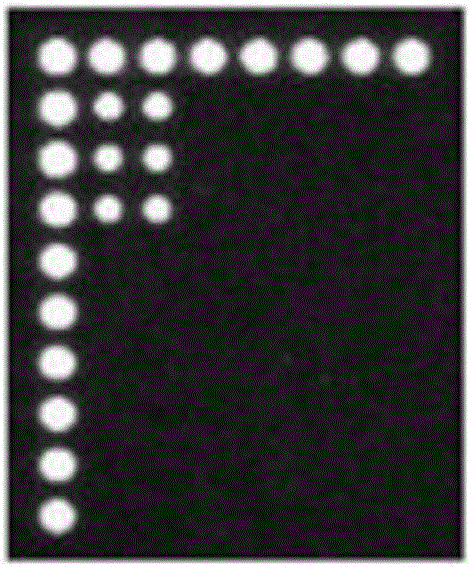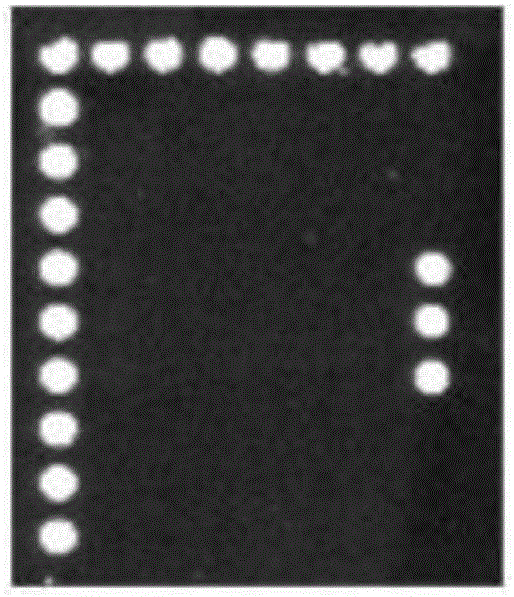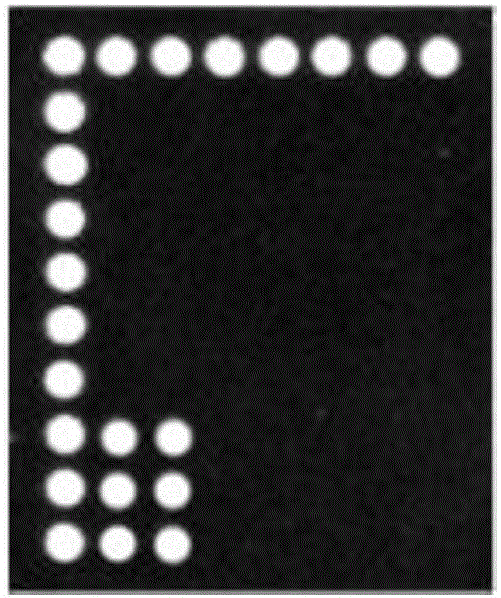Gene chip for detecting pathogenic vibrio flora in sea cucumber, shrimp and shellfish culture regions and use method
A pathogenic Vibrio and gene chip technology is applied in the field of gene chips for detecting pathogenic Vibrio groups in ginseng, shrimp and shellfish breeding areas, and can solve the problems of false positives, affecting the accuracy of test results, and easy to produce deviations.
- Summary
- Abstract
- Description
- Claims
- Application Information
AI Technical Summary
Problems solved by technology
Method used
Image
Examples
Embodiment 1
[0031] Design and synthesis of embodiment 1 probe
[0032] 1. Target detection strains and target genes
[0033] The present invention selects important common pathogenic Vibrio groups in the environment and organisms of ginseng and shellfish breeding areas as detection objects, including Vibrio parahaemolyticus, Vibrio alginolyticus, Vibrio anguillarum, Vibrio harveyi, Vibrio vulnificus, Vibrio brilliant. Vibrio parahaemolyticus uses thermostable direct hemolysin and multidrug resistance protein as target genes, Vibrio alginolyticus uses 23rDNA as target gene, Vibrio anguillarum uses methyl-accepting chemotaxis protein as target gene, Vibrio harveii uses glycolipid transfer protein as target gene For genes, Vibrio vulnificus uses methyl-accepting chemotaxis protein as the target gene, and Vibrio resplendent uses putative permeases of the drug / metabolite transporter as the target gene.
[0034] 2. Probe design
[0035] The present invention uses 18-30bp oligonucleotide prob...
Embodiment 2
[0044] The making of embodiment 2 gene chip
[0045] Utilize the probe designed in Example 1 to prepare a gene chip for detecting important common pathogenic Vibrio groups in the environment and organisms of the ginseng shellfish culture area, and the specific steps are as follows:
[0046] 1. Preparation of probe mother solution
[0047] Dilute the synthesized probe (Table 2) into a 100 μmol / L mother solution with double distilled water, and then dilute it to a concentration of 20 μmol / L with a spotting buffer;
[0048] 2. Preparation before sampling
[0049] Transfer 100 μL to wells A1, B1, C1, D1, E1, F1, G1, H1, I1, and J1 of a 96 / 384-well plate, and add 100 μL of spotting buffer to well K1;
[0050] 3. Spotting
[0051] Use the AD1500 gene chip spotting instrument of Bio-Dot Company of the United States to carry out non-contact spotting on the aldehyde substrate according to the pre-set program; the spotting volume of each point is 0.5 μL, the spot diameter is 200 μm, ...
Embodiment 3
[0059] For the method of using the important common pathogenic Vibrio gene chip (prepared in embodiment 2) in the environment and organisms of the ginseng shellfish breeding area, the specific steps are as follows:
[0060] 1. Collection and processing of samples to be tested
[0061] Use an 8 μm sterile filter membrane to remove impurities from the obtained water sample, then filter it with a 0.22 μm filter membrane and collect the filter membrane, wrap it in sterile aluminum foil, and store it at -20°C;
[0062] The mud sample is taken from 100g of sediment at the bottom 2-5cm of the breeding environment, and the collected samples are transported to the laboratory in an ice box;
[0063] Animal samples were cut with sterile scissors, rinsed with sterile water three times, put into cryopreservation tubes, and stored in liquid nitrogen.
[0064] 2. Template DNA preparation
[0065] DNA from water samples and mud samples was extracted with OMEGA Water DNA Kit (OMEGA Water DNA...
PUM
 Login to View More
Login to View More Abstract
Description
Claims
Application Information
 Login to View More
Login to View More - R&D
- Intellectual Property
- Life Sciences
- Materials
- Tech Scout
- Unparalleled Data Quality
- Higher Quality Content
- 60% Fewer Hallucinations
Browse by: Latest US Patents, China's latest patents, Technical Efficacy Thesaurus, Application Domain, Technology Topic, Popular Technical Reports.
© 2025 PatSnap. All rights reserved.Legal|Privacy policy|Modern Slavery Act Transparency Statement|Sitemap|About US| Contact US: help@patsnap.com



